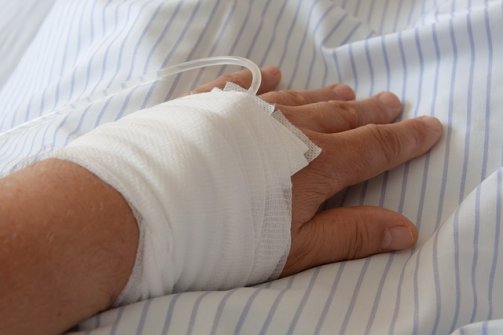Health outcomes of injured young people
Unwarranted clinical variation following hospitalised injury of young people

Project Members - Macquarie University
Rebecca Mitchell - Associate Professor E: r.mitchell@mq.edu.au
Project Main Description
Traumatic injury is the leading cause of death and a leading cause of hospitalisation for children and young people in Australia.
Beyond the initial injuries sustained, an injured child may face ongoing limitations related to their physical abilities, experience chronic pain and psychological issues, such as post-traumatic stress disorder. Their injury also impacts on their family and their community networks. Several research studies are being conducted to examine injury among children and young people in New South Wales (NSW), Australia.
- Childhood playground injury
- Injured young people and the effect of comorbid health conditions
- Unwarranted clinical variation following hospitalised injury of young people
Childhood playground injury
Falls from playground equipment are one of the most common causes of injury in children. Hospitalisation for these injuries remains high in NSW despite the implementation of safety standards.
This study examined the epidemiological profile and cost of hospitalised injuries caused by falls from playground equipment by children aged 0-14 years in NSW. Linked NSW hospitalisation data from 1 January 2010 to 30 June 2014 was used to examine hospitalisations following a of playground fall.
- Bierbaum M. Curtis K. Mitchell R. (2018) The incidence and cost of hospitalisation of children with injuries from playground equipment in New South Wales, Australia. Journal of Paediatrics and Child Health54 (5) 556-562.
Injured young people and the effect of comorbid health conditions
Injury is one of the most common reasons why a young person aged 25 years or less is hospitalised in Australia. Those with chronic disease experience longer recovery periods and higher rates of hospital readmission and death than their peers.
There is a growing number of young people with chronic diseases, such as diabetes, yet little is known about the impact of chronic disease on young people who have been traumatically injured. This study compared the health outcomes of injured young people with and without chronic disease who were hospitalised following an injury during 1 January 2010 to 30 June 2014.
Of the almost 185,000 injury hospitalisations of young people in NSW during the 4.5-year period, 13.8% had a chronic disease. Compared to young people without a chronic disease, those with one had double the average hospital cost, and a higher rate of unplanned hospital readmission and mortality. Injured young people with a chronic disease, were 3 times more likely to have a prolonged length of hospital stay.
Use of a 1:1 matched design allowed direct comparison of the average hospital length of stay and hospital costs for injured young people who were the same age and gender, who had the same nature of injury and injury severity, and who had the same socioeconomic status by their chronic disease status. Injured young people with anaemia spent an extra 6 days in hospital and their treatment cost an additional $24,000. Injured young people with diabetes spent an extra 2 days in hospital and their treatment cost an additional $2,500. Injured young people with asthma spent an extra night in hospital and their treatment cost an additional $1,500 compared to injured young people without the chronic health condition.
This research has shown that health outcomes following injury are worse for young people who have a chronic disease. The increasing number of young people with a chronic disease has direct implications for hospital treatment, resource use, provision of support services, and survival following traumatic injury.
- Mitchell R, Curtis K, Braithwaite J (2017) Health outcomes and costs for injured young people hospitalised with and without chronic health conditions. Injury 48 (8), 1776-1783
Unwarranted clinical variation following hospitalised injury of young people
This was a retrospective epidemiological study for the NSW Ministry of Health, examining both patient and hospital outcomes related to the treatment of injuries involving young people aged 25 years or less in NSW. The study linked health data from NSW emergency departments and the NSW registry of births deaths and marriages mortality data to NSW admitted patient data collection during 1 January 2010 to 30 June 2014. Binomial logistic regression models were used to generate the predicted probabilities of the three types of unwarranted clinical variation (i.e. re-presentation to emergency department within 72 hours; 28-day hospital re-admission; and 30-day mortality) for each index injury hospitalisation).
There were 189,990 injury-related hospitalisations of young people. Of these, 4.4% represented to an emergency department (ED) within 72 hours, 8.7% had an unplanned hospital readmission within 28 days, and 0.2% died within 30 days. Of the 45 public hospitals that treated ≥100 cases per year, eleven had higher than expected representations to an ED within 72 hours, six had higher than expected unplanned hospital readmissions within 28 days, and two had higher than expected all-cause mortality within 30 days.
The rates of unwarranted clinical variation among young people hospitalised for injury in NSW appear to be similar to the rates reported in other countries. However, there is considerable variation in rates of unwarranted clinical variation between public hospitals. These findings suggest that by improving routine follow-up support services post-discharge for young people and their families, it may be possible to reduce unwarranted clinical variation and improve health outcomes.
- Lystad R. Bierbaum M. Curtis K. Braithwaite J. Mitchell R. (2018) Unwarranted clinical variation in the care of children and young people hospitalised for injury: a population-based cohort study. Injury 49 (10), 1781-1786.
Project Sponsors
Office of Kids + Families, NSW Ministry of Health
Project Status
Completed
Centres Related to this Project
Content owner: Australian Institute of Health Innovation Last updated: 11 Mar 2024 6:50pm
